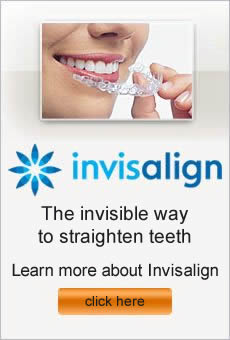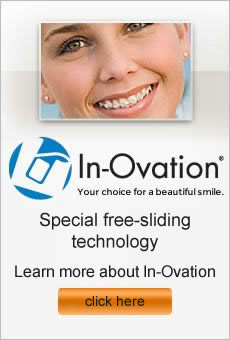When considering options for straighter teeth, you may want to look at the benefits of Invisalign versus traditional braces. Answering the question of which treatment is right for you requires consideration of several factors, including your specific dental issues, requirements, and treatment goals. Both braces and Invisalign are designed to straighten teeth while improving your smile and oral health. Here are some contrasts and comparisons you may want to consider when making a decision about the best option for straightening your teeth.
- Invisalign is removable while braces are bonded to your teeth.
- Braces are typically metal, although there are enamel color options. Invisalign is clear, or virtually invisible as the name suggests.
- Braces can be difficult to clean, requiring you to work around brackets and wires. Invisalign trays are easily removed to be rinsed and cleaned.
- Upon completion of treatment, both braces and Invisalign are likely to need an ongoing positioner or retainer.
- Braces can treat more complex orthodontia cases while Invisalign has more limited treatment abilities.
- Treatment with braces includes many food restrictions to keep from damaging the brackets and wires. Because you remove the Invisalign trays when eating, there are no restrictions to what you can eat or drink.
- For maximum treatment success, with Invisalign you must be vigilant about wearing the trays a minimum of 22 hours per day. Braces are bonded to your teeth so there is no need to worry you may forget to wear your appliance.
In comparing braces to Invisalign, it is important to determine your particular needs and consult with your orthodontist to decide which will meet those needs in the best way to achieve your treatment goals.
Dr. Fotovat is a top Invisalign orthodontist in Sherman Oaks CA
A dentist is a licensed healthcare professional whose career focuses on helping patients maintain a healthy smile by preventing diseases that affect the teeth and gums, extracting teeth, filling cavities, and inserting artificial teeth. Unlike dentists, orthodontists obtain an additional two to three years of education and primarily focus on oral alignment and positioning.
Here are some common treatment options that orthodontists employ to help patients achieve a more appealing and functional smile.
- Traditional metal braces – Metal braces have the ability to align crowded, crooked, or unevenly spaced teeth. They can correct overbites, underbites, and additional misalignments. Metal braces continue to be a popular choice for orthodontic candidates because they are very resilient, effective, and may be cost-effective compared to some of the newer styles of braces.
- Ceramic braces – Ceramic braces, also known as clear braces, are much less visible than metal braces. Ceramic braces realign the teeth and bite just as effectively as metal braces.
- Invisalign – Invisalign uses cutting edge technology to help straighten teeth often without anyone knowing you have braces. Invisalign uses aligner trays that correct teeth without using brackets, metal wires, or rubber bands. The aligner trays are made of a smooth, clear plastic material specifically shaped to fit over the teeth. The trays are practically impossible to notice, and are removable for eating and cleaning.
- Lingual braces – Lingual braces, also called incognito braces, give the desired results using custom-made wires and brackets that are specifically created for each individual tooth. Brackets and wires are then attached only to the backs of the teeth, providing a virtually invisible appearance.
- Self-ligating braces – Self-ligating braces are comprised of brackets that contain “sliding doors” to hold the wires in place. Self-ligating braces can provide results as effectively as other types of braces, and there are longer gaps between adjustments since the wires are changed less often as metal braces.
Burbank orthodontist
You may have noticed that some kids begin orthodontic treatment at a young age, and others don’t begin until their teen years. The answer is that each patient is different, and the exact reasons your child needs braces will differ from other kids. Any way you look at it, you and your orthodontist will likely share the same goals for your child of a beautiful smile, healthy teeth, and confident attitude. Wearing braces can often help achieve those goals.
Reasons for braces
There are a variety of reasons that kids can benefit from braces. They straighten overlapping teeth or move crowded teeth to achieve the best alignment. Underbites, overbites, and other problems related to how the teeth fit together can also be corrected. Jaw problems and palate issues may be addressed so that the teeth fit better in the mouth.
When to get braces
Many factors contribute to an orthodontist’s recommendation as to when your child might benefit most from treatment. Most experts advise an initial orthodontic screening around age seven, when permanent teeth start erupting. Sometimes early intervention is helpful with young children to guide the teeth, palate, and jaw during growth. Palate expanders are an example of treatment that should be done early for the best results. Early intervention isn’t recommended for all kids, because some issues must be addressed after growth is complete. Your orthodontist can identify any problems that might be treated and suggest the ideal timing for correcting them.
What braces mean for your child
Even though braces are very common among young people today, your child may still have some hesitations about treatment. Appearance is a normal concern, but there are new technologies such as Invisalign or clear braces that are less obvious than traditional braces. Fun, colorful bands may be enough to entice some children to embrace the look instead of fear it. Playing musical instruments is possible for kids with braces, and participating in sports is also acceptable as long as your child wears a mouth guard for protection.
Kids orthodontist in Sherman Oaks CA
It’s a big commitment to get braces, so you want to be as educated as possible before taking this step. Here are some important things to know before going to the orthodontist for the first time.
Braces are more than just cosmetic.
Although the goal for many people in getting braces is to achieve perfectly straight teeth, that’s not the only advantage to orthodontic treatment. The appearance of your smile may be the first thing others may notice, but braces can also improve the alignment of your jaw and bite. Serious problems and pain can result from misalignment, as well as difficulties in cleaning overcrowded teeth.
Braces aren’t just for teenagers.
Often associated with adolescence, braces are no longer only popular with this younger age group. It has become a common solution for adults who want to straighten their teeth and improve their bite. Braces can improve your smile at nearly any age.
Consultations are usually free.
The first step in considering treatment is making a consultation appointment with an orthodontist. Your teeth and jaw will be examined, and any treatment options will be presented. Consultations are usually free, so visit several specialists to find the right one for you.
Treatment and costs vary.
Don’t rule out braces because you’re afraid of the cost or the length of treatment. Your specific case is unique to you, and both treatment and financial commitment vary from patient to patient.
Braces don’t hurt as much as you might think.
A common concern about braces is the amount of pain involved. You can expect some discomfort at first and after each adjustment, but the pain is typically short-lived and manageable.
Orthodontist in Sherman Oaks CA
Look around and you’ll likely notice that braces are common in children these days. There are a variety of reasons that parents choose to go ahead and start orthodontic treatment for their children, which can help eliminate teeth and jaw problems for the rest of their lives.
Reasons for treatment
In addition to the obvious desire to improve appearance, there are other reasons for orthodontic treatment. Crooked teeth can make oral hygiene tasks difficult, so correcting problems can lead to better oral health. Jaw and teeth issues can be disfiguring, as well as possibly affect eating and speaking. An improper bite can wear down otherwise healthy teeth. Some untreated problems can damage the underlying bone structure, and some orthodontic issues can also cause pain.
Indications of problems
There are various signs to watch for that may indicate orthodontic problems in children. These include breathing with the mouth open, early tooth decay, or losing baby teeth either too early or abnormally late. Difficulties biting and chewing may mean orthodontic issues as well. The teeth and jaws might be noticeably out of proportion. Also, children who suck their thumbs, fingers, or lips often end up needing orthodontic treatment.
Early intervention
Uncorrected orthodontic issues can become worse over time, and end up more difficult and expensive to treat. It is easiest to influence teeth and jaws when growth is still taking place. Parents should take children for an orthodontic consultation when problems are observed, as treatment can begin as early as 7 years old.
Length of treatment
Orthodontic treatment usually take anywhere from a few months to a couple of years depending on the type and severity of problems. An experienced orthodontist should be able to predict treatment time based on thorough examination, including X-rays and other tests as necessary. A treatment plan may involve tooth extraction, temporary appliances, permanent appliances, or other services.
Orthodontist in Sherman Oaks for children and teens.
Your orthodontist may recommend phased orthodontic treatment for your child. Phased orthodontics is the process of treating misaligned, gapped, or crowded teeth in two separate stages of treatment.
Phased treatment typically begins when there are still primary (baby) teeth present, and can correct such issues as overbite, underbite, crossbite, or imbalanced jaw growth that could lead to problems with your child’s secondary (adult) teeth. Having your child’s orthodontist correct these issues when primary teeth are still present allows for your child’s mouth to grow and change while preserving his or her permanent smile.
In Phase I, your child will receive a thorough orthodontic evaluation by a skilled orthodontist. A first visit is recommended prior to the age of seven. The orthodontist will monitor your child’s facial jaw growth and primary tooth loss along with the eruption of any remaining permanent teeth. If your child’s orthodontist recommends phased treatment, the first treatment typically starts when your child is between the ages of six and ten.
Phase I treatment can prevent a jaw or dental developmental problems from worsening and requiring a more invasive corrective procedure when permanent teeth have descended. Some issues can lead to surgery, but early orthodontic treatment during the most appropriate times of growth can remedy these issues so that surgery isn’t required.
Phase II begins once adult teeth have fully erupted. It involves the application of braces or other orthodontic appliances. Phase I focuses on the mouth’s growth and foundation, but Phase II completes the alignment for optimal function and aesthetics. Phase II can also include the use of a retainer to maintain the ideal position of the teeth after the braces are removed.
Talk to your child’s orthodontist today to learn if your child is able to benefit from phased orthodontic treatment. Don’t wait until small problems become larger ones later.
Dr. Fotovat is an orthodontist in Sherman Oaks CA



